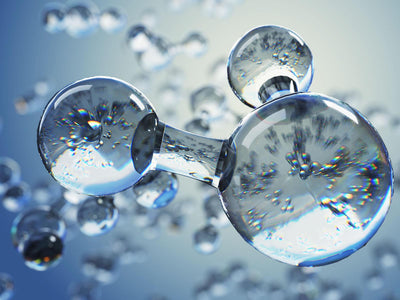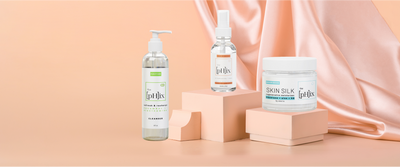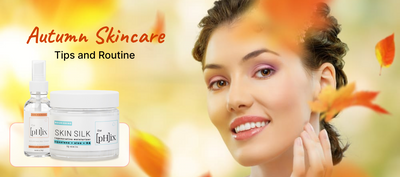All Posts

4 Easy Tips for Healthy, Happy Skin While Traveling
Traveling can indeed be stressful and can impact your skin. However, there are several tips and tricks you can follow to keep your complexion healthy and glowing while in transit. Here are some recommendations from skincare experts
4 Easy Tips for Healthy, Happy Skin While Traveling
Traveling can indeed be stressful and can impact your skin. However, there are several tips and tricks you can follow to keep your complexion healthy and glowing while in transit. Here are some recommendations from skincare experts

How Vitamin C Can Help Manage Rosacea Symptoms
If you suffer from rosacea, you know how difficult it can be to manage your symptoms. Fortunately, there are treatments available that can help ease the symptoms, one of which is vitamin C. In this article, we'll explore how vitamin C can help manage rosacea symptoms and what you need to know about this treatment option. What is Rosacea? Rosacea is a chronic skin condition that affects millions of people each year. It is characterized by facial redness, inflammation, and visible blood vessels. There are four types of rosacea, each with different symptoms, and it is often mistaken for simple redness or flushed cheeks. There is no cure for rosacea, but treatments are available to manage symptoms. What Causes Rosacea? The exact cause of rosacea is unknown, but there are several factors that may play a role in its development. Genetics, lifestyle factors, and underlying medical conditions can all contribute to the development of rosacea. Certain triggers, such as heat, cold weather, wind, exercise, alcohol, spicy food, caffeine, and stress, can also cause flare-ups. Why is Vitamin C an important rosacea treatment? Vitamin C is a valuable treatment for rosacea due to its antioxidant properties. It strengthens the skin barrier and promotes collagen production, improving skin texture and tone. Moreover, it protects against environmental damage, which can trigger rosacea flare-ups. Vitamin C helps manage rosacea symptoms and enhances the skin’s appearance. How Can Vitamin C Help Manage Rosacea Symptoms? Vitamin C is a powerful antioxidant that can help reduce inflammation and redness in the skin. It can also boost collagen production, which can improve the appearance of the skin. Vitamin C is available in many forms, such as gels, creams, serums, and capsules. If you're considering using vitamin C to manage your rosacea symptoms, be sure to talk to your doctor first. They can help you determine the best vitamin C serum for rosacea and whether it's right for you. Vitamin C rosacea treatment can be highly effective when used correctly. Why Does Vitamin C Serum Work for Rosacea? Vitamin C is a potent anti-inflammatory nutrient that can help to support weakened blood vessels. This is believed to be one of the main reasons why it is effective in treating rosacea. In addition, vitamin C also provides protection from free radicals, which can cause further damage and inflammation. Overall, vitamin C is a powerful tool in the fight against rosacea. How to Use the Best Vitamin C Serum to Treat Rosacea? When choosing the best vitamin C serum for rosacea, it's important to look for one that is specifically designed for people with rosacea. A topical vitamin C serum containing pure L-ascorbic acid is often your best bet. It's a good idea to start with a lower concentration of vitamin C to avoid irritation and work your way up to a higher concentration once you know how your skin responds to the product. The best vitamin C serum for rosacea will be gentle yet effective. Is Vitamin C Serum Really Good for Rosacea? Yes, Vitamin C serum can be beneficial for treating rosacea due to its anti-inflammatory properties. It reduces redness, improves skin quality, boosts collagen production, and protects against environmental factors, enhancing skin texture and tone. Introduce vitamin C serum slowly into your skin to avoid irritation. Other Tips for Managing Rosacea: In addition to using vitamin C, there are other things you can do to manage your rosacea symptoms. Use mild, unscented soaps and cleansers, always wear sunscreen, and consider exfoliating with a gentle salicylic acid product. Avoid triggers that can cause flare-ups, and talk to your doctor about other treatment options. If you suffer from rosacea, vitamin C can be a valuable tool in managing your symptoms. It's important to talk to your doctor first to determine the best vitamin C serum for rosacea and whether it's right for you. By using vitamin C and following other tips for managing rosacea, you can start to see improvements in your skin and reduce your symptoms. Good Skincare Tips for Rosacea-prone Skin 1. Use Alcohol Free Products: Use skincare products that are free of alcohol and fragrance. Especially those formulated for sensitive skin. 2. Hydrate Skin regularly: Keep your skin moisturized and hydrated with a gentle non-comedogenic moisturizer. 3. Protect from Sun: Always wear sunscreen with SPF 30 or higher everyday and choose formulas specifically designed for sensitive skin. 4. Avoid Touching your Face with Hands: Avoid touching your face with your hands, as frequent contact can increase rosacea, leading to increased redness and irritation. Our Top Vitamin C Products to Manage Rosacea - thephix Use [pH]iller Peptide+ Serum: Philler Peptide Serum is packed with peptides, marine algae, and antioxidants to repair the skin barrier. Suitable for all skin types, it nourishes and hydrates, making it one of the best serums for revitalizing your skin. Use Vitamin C Facial Mist Spray: Facial mist spray is formulated to refresh the skin, featuring natural AHAs for their beneficial properties. Suitable for all skin types, it can be used throughout the day for a revitalizing boost.
How Vitamin C Can Help Manage Rosacea Symptoms
If you suffer from rosacea, you know how difficult it can be to manage your symptoms. Fortunately, there are treatments available that can help ease the symptoms, one of which is vitamin C. In this article, we'll explore how vitamin C can help manage rosacea symptoms and what you need to know about this treatment option. What is Rosacea? Rosacea is a chronic skin condition that affects millions of people each year. It is characterized by facial redness, inflammation, and visible blood vessels. There are four types of rosacea, each with different symptoms, and it is often mistaken for simple redness or flushed cheeks. There is no cure for rosacea, but treatments are available to manage symptoms. What Causes Rosacea? The exact cause of rosacea is unknown, but there are several factors that may play a role in its development. Genetics, lifestyle factors, and underlying medical conditions can all contribute to the development of rosacea. Certain triggers, such as heat, cold weather, wind, exercise, alcohol, spicy food, caffeine, and stress, can also cause flare-ups. Why is Vitamin C an important rosacea treatment? Vitamin C is a valuable treatment for rosacea due to its antioxidant properties. It strengthens the skin barrier and promotes collagen production, improving skin texture and tone. Moreover, it protects against environmental damage, which can trigger rosacea flare-ups. Vitamin C helps manage rosacea symptoms and enhances the skin’s appearance. How Can Vitamin C Help Manage Rosacea Symptoms? Vitamin C is a powerful antioxidant that can help reduce inflammation and redness in the skin. It can also boost collagen production, which can improve the appearance of the skin. Vitamin C is available in many forms, such as gels, creams, serums, and capsules. If you're considering using vitamin C to manage your rosacea symptoms, be sure to talk to your doctor first. They can help you determine the best vitamin C serum for rosacea and whether it's right for you. Vitamin C rosacea treatment can be highly effective when used correctly. Why Does Vitamin C Serum Work for Rosacea? Vitamin C is a potent anti-inflammatory nutrient that can help to support weakened blood vessels. This is believed to be one of the main reasons why it is effective in treating rosacea. In addition, vitamin C also provides protection from free radicals, which can cause further damage and inflammation. Overall, vitamin C is a powerful tool in the fight against rosacea. How to Use the Best Vitamin C Serum to Treat Rosacea? When choosing the best vitamin C serum for rosacea, it's important to look for one that is specifically designed for people with rosacea. A topical vitamin C serum containing pure L-ascorbic acid is often your best bet. It's a good idea to start with a lower concentration of vitamin C to avoid irritation and work your way up to a higher concentration once you know how your skin responds to the product. The best vitamin C serum for rosacea will be gentle yet effective. Is Vitamin C Serum Really Good for Rosacea? Yes, Vitamin C serum can be beneficial for treating rosacea due to its anti-inflammatory properties. It reduces redness, improves skin quality, boosts collagen production, and protects against environmental factors, enhancing skin texture and tone. Introduce vitamin C serum slowly into your skin to avoid irritation. Other Tips for Managing Rosacea: In addition to using vitamin C, there are other things you can do to manage your rosacea symptoms. Use mild, unscented soaps and cleansers, always wear sunscreen, and consider exfoliating with a gentle salicylic acid product. Avoid triggers that can cause flare-ups, and talk to your doctor about other treatment options. If you suffer from rosacea, vitamin C can be a valuable tool in managing your symptoms. It's important to talk to your doctor first to determine the best vitamin C serum for rosacea and whether it's right for you. By using vitamin C and following other tips for managing rosacea, you can start to see improvements in your skin and reduce your symptoms. Good Skincare Tips for Rosacea-prone Skin 1. Use Alcohol Free Products: Use skincare products that are free of alcohol and fragrance. Especially those formulated for sensitive skin. 2. Hydrate Skin regularly: Keep your skin moisturized and hydrated with a gentle non-comedogenic moisturizer. 3. Protect from Sun: Always wear sunscreen with SPF 30 or higher everyday and choose formulas specifically designed for sensitive skin. 4. Avoid Touching your Face with Hands: Avoid touching your face with your hands, as frequent contact can increase rosacea, leading to increased redness and irritation. Our Top Vitamin C Products to Manage Rosacea - thephix Use [pH]iller Peptide+ Serum: Philler Peptide Serum is packed with peptides, marine algae, and antioxidants to repair the skin barrier. Suitable for all skin types, it nourishes and hydrates, making it one of the best serums for revitalizing your skin. Use Vitamin C Facial Mist Spray: Facial mist spray is formulated to refresh the skin, featuring natural AHAs for their beneficial properties. Suitable for all skin types, it can be used throughout the day for a revitalizing boost.

6 Winter Skincare Tips For Everyone, Including Those With Dry Skin
Here are the 6 best winter skincare tips, especially for those with dry skin...
6 Winter Skincare Tips For Everyone, Including Those With Dry Skin
Here are the 6 best winter skincare tips, especially for those with dry skin...

Everything You Need to Know about Double Cleansing
If you’re looking for a thorough and effective way to cleanse your skin of dirt, makeup, and excess oil, you should definitely try double cleansing. This method involves using two cleansers - one oil-based and one water-based - to deeply cleanse your face and leave your skin feeling refreshed, nourished, and balanced.
Everything You Need to Know about Double Cleansing
If you’re looking for a thorough and effective way to cleanse your skin of dirt, makeup, and excess oil, you should definitely try double cleansing. This method involves using two cleansers - one oil-based and one water-based - to deeply cleanse your face and leave your skin feeling refreshed, nourished, and balanced.

5 Travel Skincare Tips when Flying Home for the Holidays
...I'll share 5 skincare tips to help you make the most of your holiday travels. From selecting the right products to carrying the right items, these tips will ensure that your skin looks and feels its best when you arrive at your destination.
5 Travel Skincare Tips when Flying Home for the Holidays
...I'll share 5 skincare tips to help you make the most of your holiday travels. From selecting the right products to carrying the right items, these tips will ensure that your skin looks and feels its best when you arrive at your destination.
![Caffeine Eye Cream by the [pH]ix](http://thephix.co/cdn/shop/articles/DSC07859.jpg?v=1678302908&width=400)
Reduce Puffy Eyes with Under Eye Creams Containing Caffeine
Caffeine is one of the most effective ingredients in under-eye creams. It works as a natural diuretic, which can help relieve water retention and reduce puffiness. It is also a vasoconstrictor that tightens and constricts blood vessels, which can help tighten the skin under the eyes and reduce puffiness.
Reduce Puffy Eyes with Under Eye Creams Containing Caffeine
Caffeine is one of the most effective ingredients in under-eye creams. It works as a natural diuretic, which can help relieve water retention and reduce puffiness. It is also a vasoconstrictor that tightens and constricts blood vessels, which can help tighten the skin under the eyes and reduce puffiness.

please, stop mixing your SPF with your moisturizer
SPF is essential? Absolutely. We should be using a moisturizer at least 2x/day, every day? You bet. ...so for the sake of saving time, I can just mix these, right? Well...no. While I see the logic behind this, and I was guilty of doing this myself years ago, it is simply.... not the move. Your moisturizer + SPF should be two staples in your skincare routine no matter what, but mixing them together detracts from the efficacy of both. Let me explain why: 1. Mixing them makes your sunscreen easier to spread, but you're in turn reducing the amount of sunscreen that you are applying to your face & getting less coverage because of that. If spread is an issue, I recommend opting for a chemical sunscreen that rubs in a little easier than a strict mineral sunscreen. 2. Mixing the two alters the chemical makeup of the sunscreen, diluting it and decreasing the efficacy. Sunscreen formulation is NOT easy-- countless hours of research, trial & error, and strict approvals go behind each formula. Adding the chemical makeup of your lotion to that sunscreen throws it off balance and may impair the UV filters. Suggestion: After cleansing + applying your serums, go in with your face lotion first. Allow that to dry & apply your sunscreen on top of that. Tinted moisturizers and makeup with SPF can be helpful, but nothing beats using a dedicated moisturizer and true sunscreen for the best protection. For sensitive skin, pairing a good SPF moisturizer for sensitive skin with Vitamin C and E can provide added coverage and nourish the skin. This combination is the ultimate way to protect and hydrate your skin.
please, stop mixing your SPF with your moisturizer
SPF is essential? Absolutely. We should be using a moisturizer at least 2x/day, every day? You bet. ...so for the sake of saving time, I can just mix these, right? Well...no. While I see the logic behind this, and I was guilty of doing this myself years ago, it is simply.... not the move. Your moisturizer + SPF should be two staples in your skincare routine no matter what, but mixing them together detracts from the efficacy of both. Let me explain why: 1. Mixing them makes your sunscreen easier to spread, but you're in turn reducing the amount of sunscreen that you are applying to your face & getting less coverage because of that. If spread is an issue, I recommend opting for a chemical sunscreen that rubs in a little easier than a strict mineral sunscreen. 2. Mixing the two alters the chemical makeup of the sunscreen, diluting it and decreasing the efficacy. Sunscreen formulation is NOT easy-- countless hours of research, trial & error, and strict approvals go behind each formula. Adding the chemical makeup of your lotion to that sunscreen throws it off balance and may impair the UV filters. Suggestion: After cleansing + applying your serums, go in with your face lotion first. Allow that to dry & apply your sunscreen on top of that. Tinted moisturizers and makeup with SPF can be helpful, but nothing beats using a dedicated moisturizer and true sunscreen for the best protection. For sensitive skin, pairing a good SPF moisturizer for sensitive skin with Vitamin C and E can provide added coverage and nourish the skin. This combination is the ultimate way to protect and hydrate your skin.

what are those first 3 ingredients?
we want you to be an informed consumer.
 is here! Shop now, pay later in 4 easy installments
is here! Shop now, pay later in 4 easy installments



